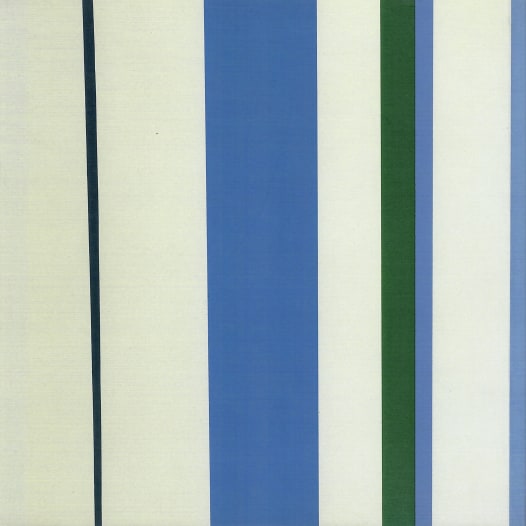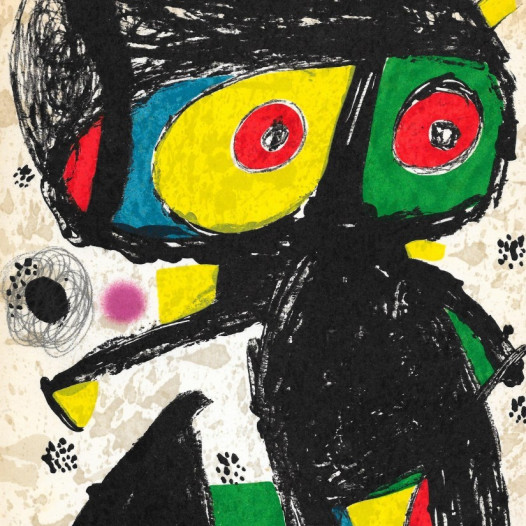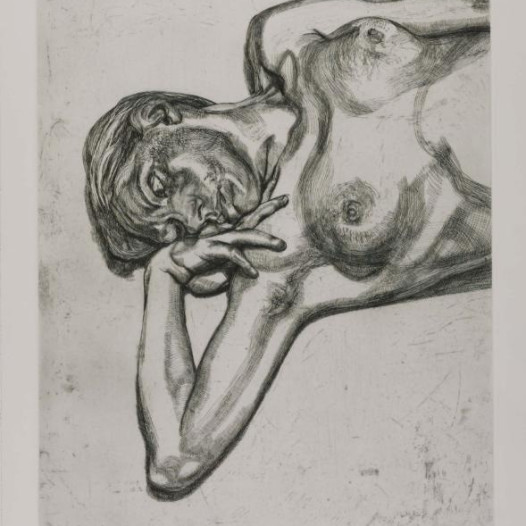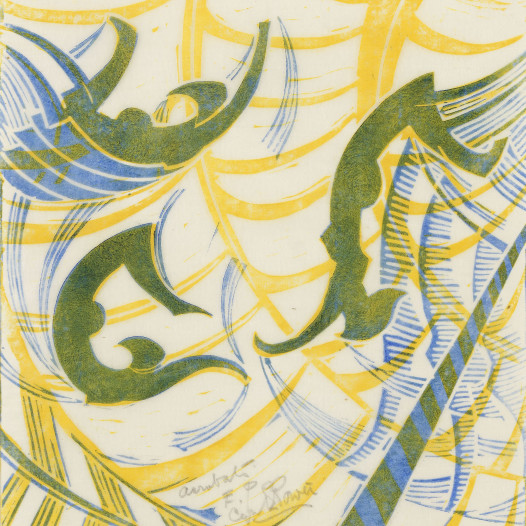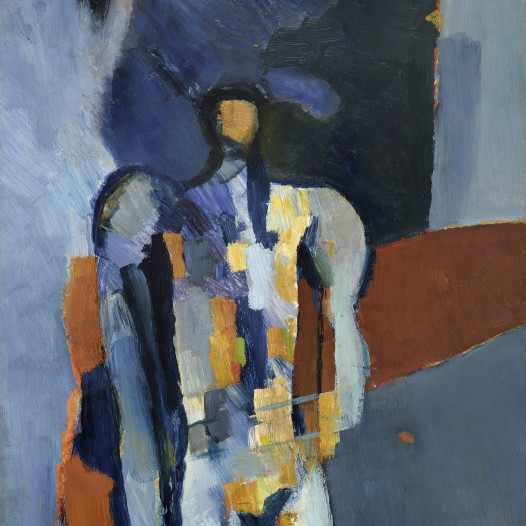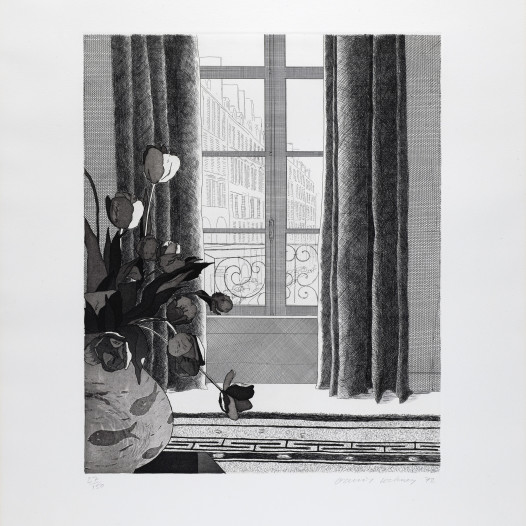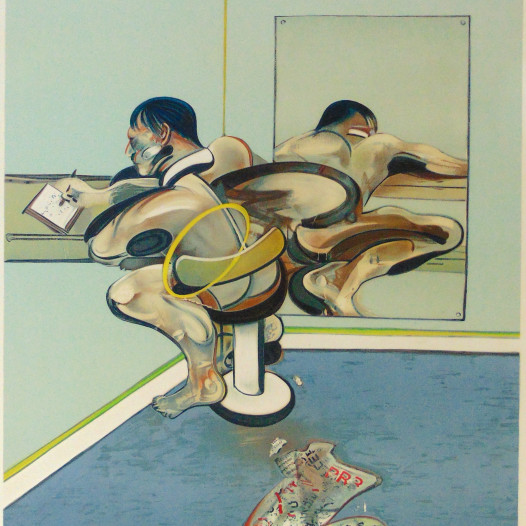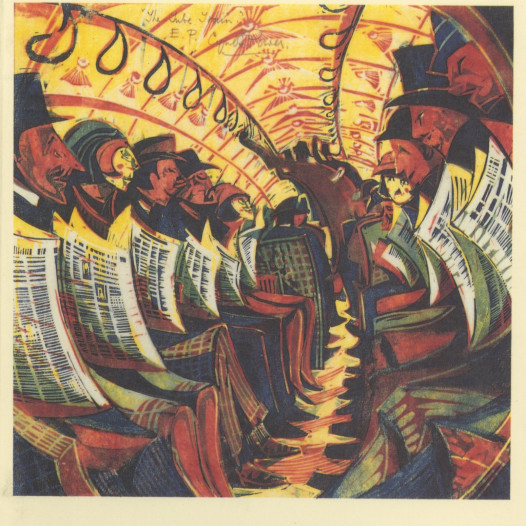Cyril Edward Power
1872–1951Cyril Power, born in Chelsea, in 1872, is primarily known for his association with the Grosvenor School of Modern Art and for his mastery of linocut.
Having trained as an architect, Power was awarded the Sloane Medallion in 1900 by the Royal Institute of British Architects, where he was elected an associate member. He pursued a career in architecture until the early 1920s. In the run-up to this period, he had begun to produce watercolours and drypoint etchings, mainly of landscapes and urban scenes. It has been speculated that the horrors he saw and experienced during air raids as part of the Royal Flying Corps in WWI contributed significantly to his sharp change of careers. In 1921 Power had a joint exhibition with Sybil Andrews in her home town of Bury St. Edmunds.
In 1922 Power and Sybil Andrews moved to London, where Power initially studied at Heatherley’s School of Fine Art, before leaving to work as a lecturer in architecture at Grosvenor School of Modern Art. It was here that they were taught by Claude Flight, and came to embrace the colourful use of linocuts. He used this method to create dynamic, futuristic prints of the London underground and sporting events, amongst other modern subjects.
Power and Andrews lived and collaborated in London until they gave up their shared studio in 1938 and went their separate ways. Before this, they had both flourished. They exhibited together at Claude Flight’s The First Exhibition of British Lino-Cuts at the Redfern Gallery (which spawned a series of annual exhibitions) and they jointly designed posters for the London Passengers Transport Board from 1929 to 1937, promoting the use of the system under the pseudonym "Andrew-Power". In 1930, Power was elected a member of the Royal Society of British Artists.
Following the outbreak of war in 1938, Power worked as a surveyor for the Heavy Rescue Squad at Wandsworth Town Hall. He combined this with work lecturing on painting and linocutting in New Malden and Kingston. In the later years of his life, he moved away from scenes of city life and produced oil paintings of Cornish landscapes and of flowers. He died in London in May 1951.
Power’s work is held in collections worldwide, including the British Museum, National Gallery of Australia, and the Museum of Modern Art, New York. He was widely exhibited in his lifetime, particularly as part of the Grosvenor School, and his importance is still recognized today.
Works
-
 Cyril Edward PowerThe Concerto, 1935Linocut32 x 30 cmFrom the edition of 60 impressionsSigned, numbered, and titled upper left%3Cdiv%20class%3D%22artist%22%3E%3Cspan%20class%3D%22artist%22%3E%3Cstrong%3ECyril%20Edward%20Power%3C/strong%3E%3C/span%3E%3C/div%3E%0D%3Cdiv%20class%3D%22title%22%3E%3Cem%3EThe%20Concerto%3C/em%3E%2C%201935%3C/div%3E%0D%3Cdiv%20class%3D%22signed_and_dated%22%3ESigned%2C%20numbered%2C%20and%20titled%20upper%20left%3C/div%3E%0D%3Cdiv%20class%3D%22medium%22%3ELinocut%20%3C/div%3E%0D%3Cdiv%20class%3D%22dimensions%22%3E32%20x%2030%20cm%3C/div%3E%0D%3Cdiv%20class%3D%22edition_details%22%3EFrom%20the%20edition%20of%2060%20impressions%3C/div%3E
Cyril Edward PowerThe Concerto, 1935Linocut32 x 30 cmFrom the edition of 60 impressionsSigned, numbered, and titled upper left%3Cdiv%20class%3D%22artist%22%3E%3Cspan%20class%3D%22artist%22%3E%3Cstrong%3ECyril%20Edward%20Power%3C/strong%3E%3C/span%3E%3C/div%3E%0D%3Cdiv%20class%3D%22title%22%3E%3Cem%3EThe%20Concerto%3C/em%3E%2C%201935%3C/div%3E%0D%3Cdiv%20class%3D%22signed_and_dated%22%3ESigned%2C%20numbered%2C%20and%20titled%20upper%20left%3C/div%3E%0D%3Cdiv%20class%3D%22medium%22%3ELinocut%20%3C/div%3E%0D%3Cdiv%20class%3D%22dimensions%22%3E32%20x%2030%20cm%3C/div%3E%0D%3Cdiv%20class%3D%22edition_details%22%3EFrom%20the%20edition%20of%2060%20impressions%3C/div%3E -
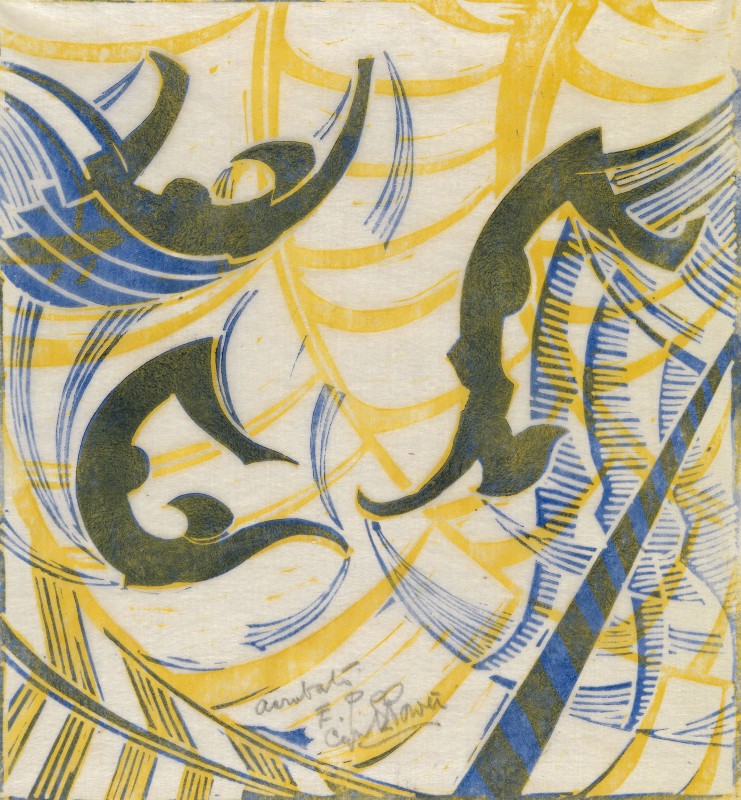 Cyril Edward PowerAcrobats, 1933Linocut25.4 x 23.2 cmThis is a proof, in a unique colour combination, aside the edition of 60 impressionsSigned, inscribed, and titled lower centre%3Cdiv%20class%3D%22artist%22%3E%3Cspan%20class%3D%22artist%22%3E%3Cstrong%3ECyril%20Edward%20Power%3C/strong%3E%3C/span%3E%3C/div%3E%0D%3Cdiv%20class%3D%22title%22%3E%3Cem%3EAcrobats%3C/em%3E%2C%201933%3C/div%3E%0D%3Cdiv%20class%3D%22signed_and_dated%22%3ESigned%2C%20inscribed%2C%20and%20titled%20lower%20centre%3C/div%3E%0D%3Cdiv%20class%3D%22medium%22%3ELinocut%20%3C/div%3E%0D%3Cdiv%20class%3D%22dimensions%22%3E25.4%20x%2023.2%20cm%3C/div%3E%0D%3Cdiv%20class%3D%22edition_details%22%3EThis%20is%20a%20proof%2C%20in%20a%20unique%20colour%20combination%2C%20aside%20the%20edition%20of%2060%20impressions%3C/div%3E
Cyril Edward PowerAcrobats, 1933Linocut25.4 x 23.2 cmThis is a proof, in a unique colour combination, aside the edition of 60 impressionsSigned, inscribed, and titled lower centre%3Cdiv%20class%3D%22artist%22%3E%3Cspan%20class%3D%22artist%22%3E%3Cstrong%3ECyril%20Edward%20Power%3C/strong%3E%3C/span%3E%3C/div%3E%0D%3Cdiv%20class%3D%22title%22%3E%3Cem%3EAcrobats%3C/em%3E%2C%201933%3C/div%3E%0D%3Cdiv%20class%3D%22signed_and_dated%22%3ESigned%2C%20inscribed%2C%20and%20titled%20lower%20centre%3C/div%3E%0D%3Cdiv%20class%3D%22medium%22%3ELinocut%20%3C/div%3E%0D%3Cdiv%20class%3D%22dimensions%22%3E25.4%20x%2023.2%20cm%3C/div%3E%0D%3Cdiv%20class%3D%22edition_details%22%3EThis%20is%20a%20proof%2C%20in%20a%20unique%20colour%20combination%2C%20aside%20the%20edition%20of%2060%20impressions%3C/div%3E -
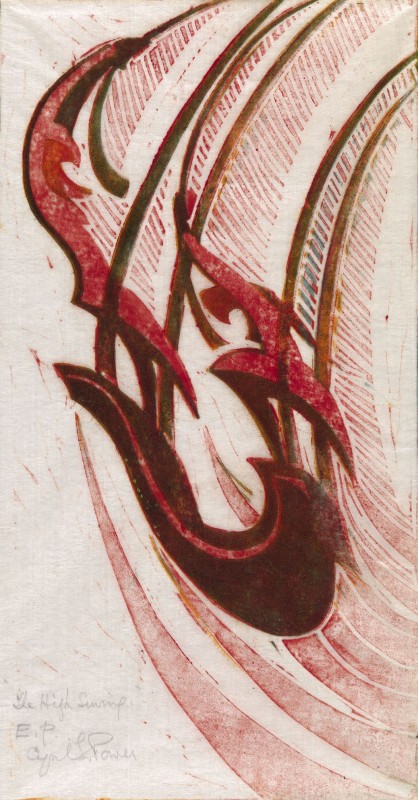 Cyril Edward PowerThe High Swing, 1933Linocut30 x 15.6 cmA colour proof in red - aside from the standard edition of 60 impressionsSigned and titled lower left%3Cdiv%20class%3D%22artist%22%3E%3Cspan%20class%3D%22artist%22%3E%3Cstrong%3ECyril%20Edward%20Power%3C/strong%3E%3C/span%3E%3C/div%3E%0D%3Cdiv%20class%3D%22title%22%3E%3Cem%3EThe%20High%20Swing%3C/em%3E%2C%201933%3C/div%3E%0D%3Cdiv%20class%3D%22signed_and_dated%22%3ESigned%20and%20titled%20lower%20left%3C/div%3E%0D%3Cdiv%20class%3D%22medium%22%3ELinocut%3C/div%3E%0D%3Cdiv%20class%3D%22dimensions%22%3E30%20x%2015.6%20cm%3C/div%3E%0D%3Cdiv%20class%3D%22edition_details%22%3EA%20colour%20proof%20in%20red%20-%20aside%20from%20the%20standard%20edition%20of%2060%20impressions%20%3C/div%3E
Cyril Edward PowerThe High Swing, 1933Linocut30 x 15.6 cmA colour proof in red - aside from the standard edition of 60 impressionsSigned and titled lower left%3Cdiv%20class%3D%22artist%22%3E%3Cspan%20class%3D%22artist%22%3E%3Cstrong%3ECyril%20Edward%20Power%3C/strong%3E%3C/span%3E%3C/div%3E%0D%3Cdiv%20class%3D%22title%22%3E%3Cem%3EThe%20High%20Swing%3C/em%3E%2C%201933%3C/div%3E%0D%3Cdiv%20class%3D%22signed_and_dated%22%3ESigned%20and%20titled%20lower%20left%3C/div%3E%0D%3Cdiv%20class%3D%22medium%22%3ELinocut%3C/div%3E%0D%3Cdiv%20class%3D%22dimensions%22%3E30%20x%2015.6%20cm%3C/div%3E%0D%3Cdiv%20class%3D%22edition_details%22%3EA%20colour%20proof%20in%20red%20-%20aside%20from%20the%20standard%20edition%20of%2060%20impressions%20%3C/div%3E -
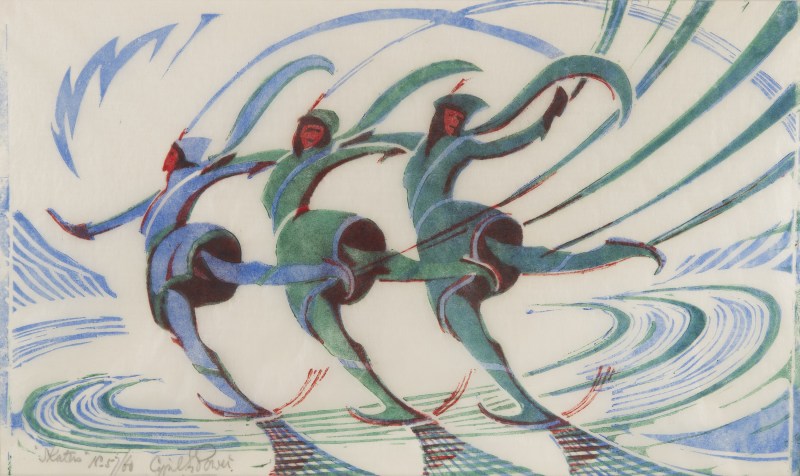 Cyril Edward PowerSkaters, 1932Linocut19.8 x 31.6 cm%3Cdiv%20class%3D%22artist%22%3E%3Cspan%20class%3D%22artist%22%3E%3Cstrong%3ECyril%20Edward%20Power%3C/strong%3E%3C/span%3E%3C/div%3E%0D%3Cdiv%20class%3D%22title%22%3E%3Cem%3ESkaters%3C/em%3E%2C%201932%3C/div%3E%0D%3Cdiv%20class%3D%22medium%22%3ELinocut%3C/div%3E%0D%3Cdiv%20class%3D%22dimensions%22%3E19.8%20x%2031.6%20cm%3C/div%3E
Cyril Edward PowerSkaters, 1932Linocut19.8 x 31.6 cm%3Cdiv%20class%3D%22artist%22%3E%3Cspan%20class%3D%22artist%22%3E%3Cstrong%3ECyril%20Edward%20Power%3C/strong%3E%3C/span%3E%3C/div%3E%0D%3Cdiv%20class%3D%22title%22%3E%3Cem%3ESkaters%3C/em%3E%2C%201932%3C/div%3E%0D%3Cdiv%20class%3D%22medium%22%3ELinocut%3C/div%3E%0D%3Cdiv%20class%3D%22dimensions%22%3E19.8%20x%2031.6%20cm%3C/div%3E -
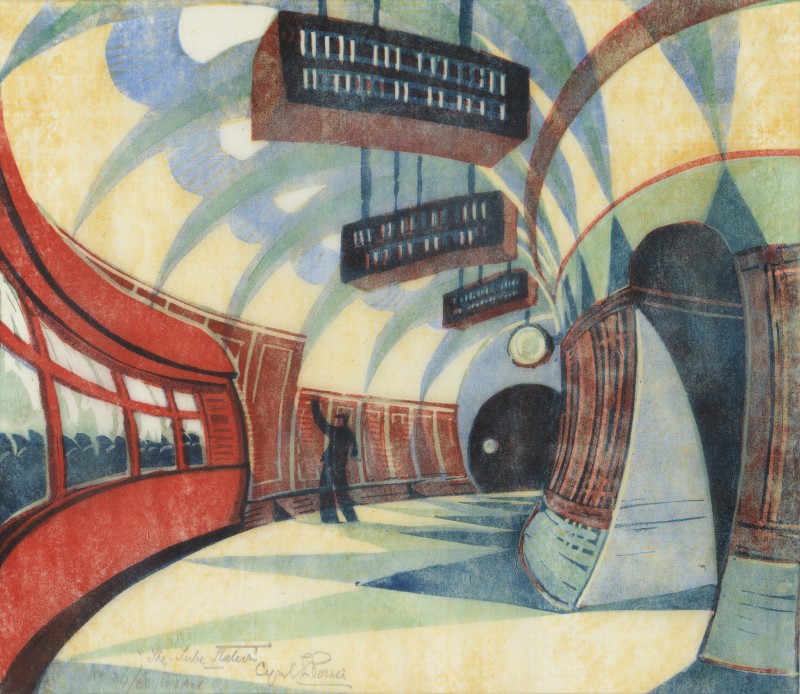 Cyril Edward PowerThe Tube Station, 1932Linocut26 x 30 cmFrom the edition of 60 impressionsSigned, titled and numbered lower left%3Cdiv%20class%3D%22artist%22%3E%3Cspan%20class%3D%22artist%22%3E%3Cstrong%3ECyril%20Edward%20Power%3C/strong%3E%3C/span%3E%3C/div%3E%0D%3Cdiv%20class%3D%22title%22%3E%3Cem%3EThe%20Tube%20Station%3C/em%3E%2C%201932%3C/div%3E%0D%3Cdiv%20class%3D%22signed_and_dated%22%3ESigned%2C%20titled%20and%20numbered%20lower%20left%3C/div%3E%0D%3Cdiv%20class%3D%22medium%22%3ELinocut%3C/div%3E%0D%3Cdiv%20class%3D%22dimensions%22%3E26%20x%2030%20cm%3C/div%3E%0D%3Cdiv%20class%3D%22edition_details%22%3EFrom%20the%20edition%20of%2060%20impressions%3C/div%3E
Cyril Edward PowerThe Tube Station, 1932Linocut26 x 30 cmFrom the edition of 60 impressionsSigned, titled and numbered lower left%3Cdiv%20class%3D%22artist%22%3E%3Cspan%20class%3D%22artist%22%3E%3Cstrong%3ECyril%20Edward%20Power%3C/strong%3E%3C/span%3E%3C/div%3E%0D%3Cdiv%20class%3D%22title%22%3E%3Cem%3EThe%20Tube%20Station%3C/em%3E%2C%201932%3C/div%3E%0D%3Cdiv%20class%3D%22signed_and_dated%22%3ESigned%2C%20titled%20and%20numbered%20lower%20left%3C/div%3E%0D%3Cdiv%20class%3D%22medium%22%3ELinocut%3C/div%3E%0D%3Cdiv%20class%3D%22dimensions%22%3E26%20x%2030%20cm%3C/div%3E%0D%3Cdiv%20class%3D%22edition_details%22%3EFrom%20the%20edition%20of%2060%20impressions%3C/div%3E -
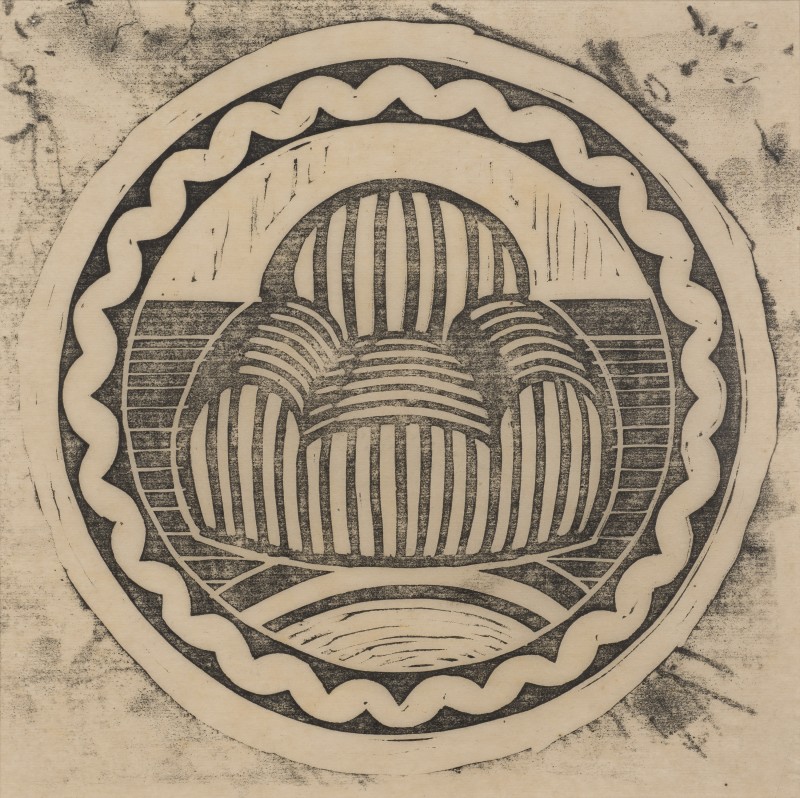 Cyril Edward PowerStriped Armchair, 1930 (c.)Linocut38 x 25 cmNot editionedUnsigned proof%3Cdiv%20class%3D%22artist%22%3E%3Cspan%20class%3D%22artist%22%3E%3Cstrong%3ECyril%20Edward%20Power%3C/strong%3E%3C/span%3E%3C/div%3E%0D%3Cdiv%20class%3D%22title%22%3E%3Cem%3EStriped%20Armchair%3C/em%3E%2C%201930%20%28c.%29%3C/div%3E%0D%3Cdiv%20class%3D%22signed_and_dated%22%3EUnsigned%20proof%3C/div%3E%0D%3Cdiv%20class%3D%22medium%22%3ELinocut%3C/div%3E%0D%3Cdiv%20class%3D%22dimensions%22%3E38%20x%2025%20cm%3C/div%3E%0D%3Cdiv%20class%3D%22edition_details%22%3ENot%20editioned%3C/div%3E
Cyril Edward PowerStriped Armchair, 1930 (c.)Linocut38 x 25 cmNot editionedUnsigned proof%3Cdiv%20class%3D%22artist%22%3E%3Cspan%20class%3D%22artist%22%3E%3Cstrong%3ECyril%20Edward%20Power%3C/strong%3E%3C/span%3E%3C/div%3E%0D%3Cdiv%20class%3D%22title%22%3E%3Cem%3EStriped%20Armchair%3C/em%3E%2C%201930%20%28c.%29%3C/div%3E%0D%3Cdiv%20class%3D%22signed_and_dated%22%3EUnsigned%20proof%3C/div%3E%0D%3Cdiv%20class%3D%22medium%22%3ELinocut%3C/div%3E%0D%3Cdiv%20class%3D%22dimensions%22%3E38%20x%2025%20cm%3C/div%3E%0D%3Cdiv%20class%3D%22edition_details%22%3ENot%20editioned%3C/div%3E -
 Cyril Edward PowerThe Runners, 1930Linocut17.3 x 34.6 cmFrom the edition of 50 impressionsSigned, titled and numbered lower left%3Cdiv%20class%3D%22artist%22%3E%3Cspan%20class%3D%22artist%22%3E%3Cstrong%3ECyril%20Edward%20Power%3C/strong%3E%3C/span%3E%3C/div%3E%0D%3Cdiv%20class%3D%22title%22%3E%3Cem%3EThe%20Runners%3C/em%3E%2C%201930%3C/div%3E%0D%3Cdiv%20class%3D%22signed_and_dated%22%3ESigned%2C%20titled%20and%20numbered%20lower%20left%3C/div%3E%0D%3Cdiv%20class%3D%22medium%22%3ELinocut%20%3C/div%3E%0D%3Cdiv%20class%3D%22dimensions%22%3E17.3%20x%2034.6%20cm%3C/div%3E%0D%3Cdiv%20class%3D%22edition_details%22%3EFrom%20the%20edition%20of%2050%20impressions%3C/div%3E
Cyril Edward PowerThe Runners, 1930Linocut17.3 x 34.6 cmFrom the edition of 50 impressionsSigned, titled and numbered lower left%3Cdiv%20class%3D%22artist%22%3E%3Cspan%20class%3D%22artist%22%3E%3Cstrong%3ECyril%20Edward%20Power%3C/strong%3E%3C/span%3E%3C/div%3E%0D%3Cdiv%20class%3D%22title%22%3E%3Cem%3EThe%20Runners%3C/em%3E%2C%201930%3C/div%3E%0D%3Cdiv%20class%3D%22signed_and_dated%22%3ESigned%2C%20titled%20and%20numbered%20lower%20left%3C/div%3E%0D%3Cdiv%20class%3D%22medium%22%3ELinocut%20%3C/div%3E%0D%3Cdiv%20class%3D%22dimensions%22%3E17.3%20x%2034.6%20cm%3C/div%3E%0D%3Cdiv%20class%3D%22edition_details%22%3EFrom%20the%20edition%20of%2050%20impressions%3C/div%3E -
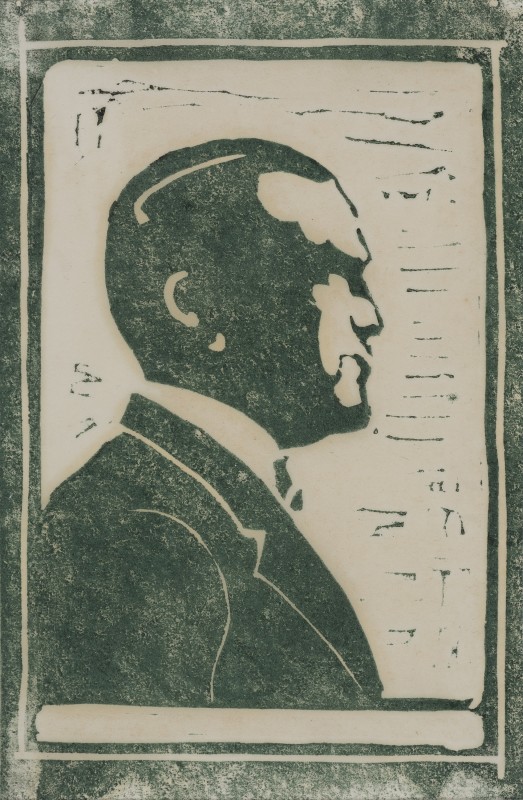 Cyril Edward PowerSelf-Portrait, 1927Linocut14.4 x 9.3 cmPrinted on tissue paper. Numbered 14.Unsigned%3Cdiv%20class%3D%22artist%22%3E%3Cspan%20class%3D%22artist%22%3E%3Cstrong%3ECyril%20Edward%20Power%3C/strong%3E%3C/span%3E%3C/div%3E%0D%3Cdiv%20class%3D%22title%22%3E%3Cem%3ESelf-Portrait%3C/em%3E%2C%201927%3C/div%3E%0D%3Cdiv%20class%3D%22signed_and_dated%22%3EUnsigned%3C/div%3E%0D%3Cdiv%20class%3D%22medium%22%3ELinocut%3C/div%3E%0D%3Cdiv%20class%3D%22dimensions%22%3E14.4%20x%209.3%20cm%3C/div%3E%0D%3Cdiv%20class%3D%22edition_details%22%3EPrinted%20on%20tissue%20paper.%20Numbered%2014.%3C/div%3E
Cyril Edward PowerSelf-Portrait, 1927Linocut14.4 x 9.3 cmPrinted on tissue paper. Numbered 14.Unsigned%3Cdiv%20class%3D%22artist%22%3E%3Cspan%20class%3D%22artist%22%3E%3Cstrong%3ECyril%20Edward%20Power%3C/strong%3E%3C/span%3E%3C/div%3E%0D%3Cdiv%20class%3D%22title%22%3E%3Cem%3ESelf-Portrait%3C/em%3E%2C%201927%3C/div%3E%0D%3Cdiv%20class%3D%22signed_and_dated%22%3EUnsigned%3C/div%3E%0D%3Cdiv%20class%3D%22medium%22%3ELinocut%3C/div%3E%0D%3Cdiv%20class%3D%22dimensions%22%3E14.4%20x%209.3%20cm%3C/div%3E%0D%3Cdiv%20class%3D%22edition_details%22%3EPrinted%20on%20tissue%20paper.%20Numbered%2014.%3C/div%3E -
 Cyril Edward PowerThe Bridge, Rickmansworth, 1926 (c.)Linocut13 x 15 cmEdition size unknownUnsigned and unnumbered proof%3Cdiv%20class%3D%22artist%22%3E%3Cspan%20class%3D%22artist%22%3E%3Cstrong%3ECyril%20Edward%20Power%3C/strong%3E%3C/span%3E%3C/div%3E%0D%3Cdiv%20class%3D%22title%22%3E%3Cem%3EThe%20Bridge%2C%20Rickmansworth%3C/em%3E%2C%201926%20%28c.%29%3C/div%3E%0D%3Cdiv%20class%3D%22signed_and_dated%22%3EUnsigned%20and%20unnumbered%20proof%3C/div%3E%0D%3Cdiv%20class%3D%22medium%22%3ELinocut%3C/div%3E%0D%3Cdiv%20class%3D%22dimensions%22%3E13%20x%2015%20cm%3C/div%3E%0D%3Cdiv%20class%3D%22edition_details%22%3EEdition%20size%20unknown%3C/div%3E
Cyril Edward PowerThe Bridge, Rickmansworth, 1926 (c.)Linocut13 x 15 cmEdition size unknownUnsigned and unnumbered proof%3Cdiv%20class%3D%22artist%22%3E%3Cspan%20class%3D%22artist%22%3E%3Cstrong%3ECyril%20Edward%20Power%3C/strong%3E%3C/span%3E%3C/div%3E%0D%3Cdiv%20class%3D%22title%22%3E%3Cem%3EThe%20Bridge%2C%20Rickmansworth%3C/em%3E%2C%201926%20%28c.%29%3C/div%3E%0D%3Cdiv%20class%3D%22signed_and_dated%22%3EUnsigned%20and%20unnumbered%20proof%3C/div%3E%0D%3Cdiv%20class%3D%22medium%22%3ELinocut%3C/div%3E%0D%3Cdiv%20class%3D%22dimensions%22%3E13%20x%2015%20cm%3C/div%3E%0D%3Cdiv%20class%3D%22edition_details%22%3EEdition%20size%20unknown%3C/div%3E
